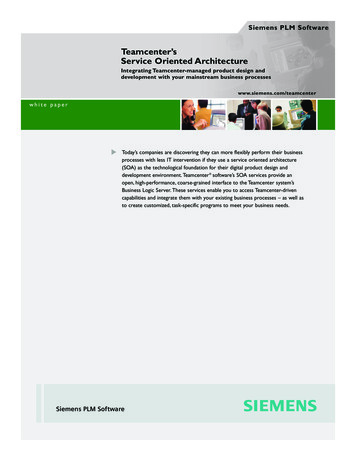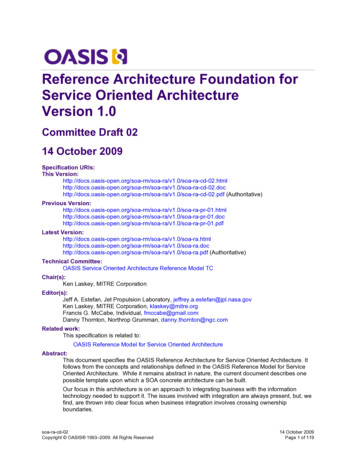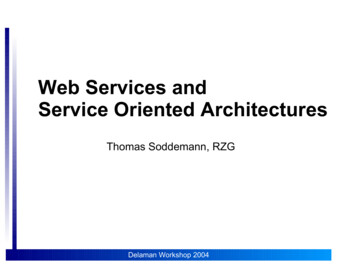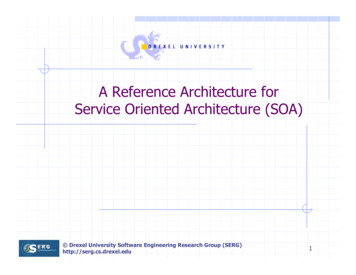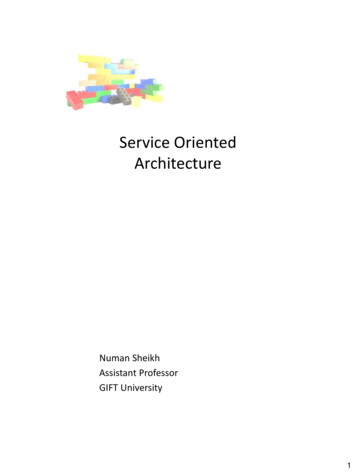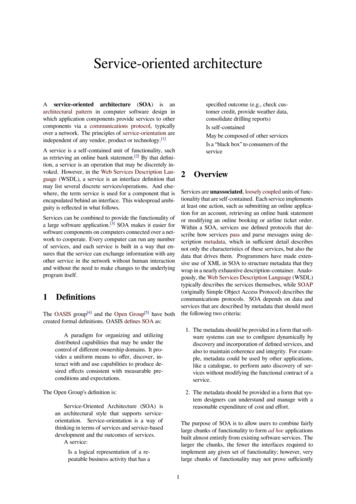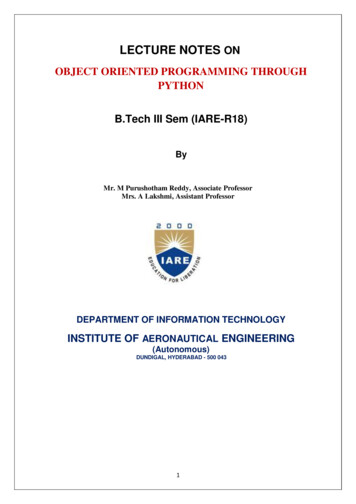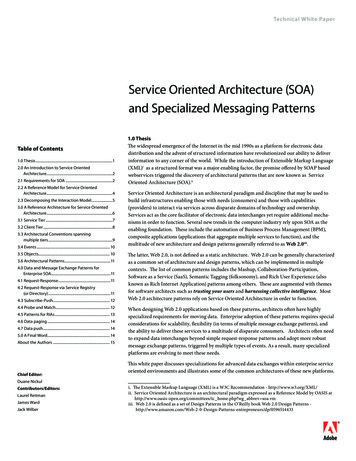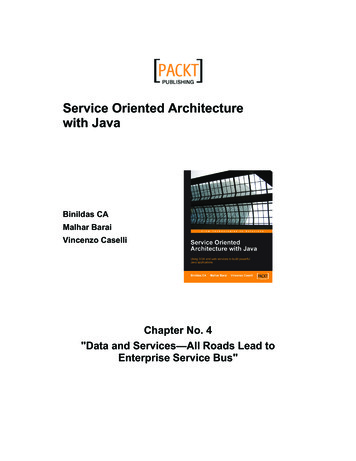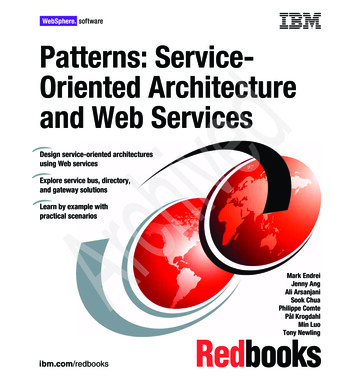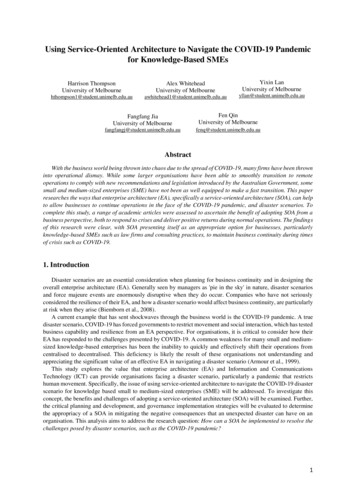
Transcription
Using Service-Oriented Architecture to Navigate the COVID-19 Pandemicfor Knowledge-Based SMEsHarrison ThompsonUniversity of MelbourneAlex WhiteheadUniversity of MelbourneYixin LanUniversity of u.auFangfang JiaUniversity of MelbourneFen QinUniversity of ent.unimelb.edu.auAbstractWith the business world being thrown into chaos due to the spread of COVID-19, many firms have been throwninto operational dismay. While some larger organisations have been able to smoothly transition to remoteoperations to comply with new recommendations and legislation introduced by the Australian Government, somesmall and medium-sized enterprises (SME) have not been as well equipped to make a fast transition. This paperresearches the ways that enterprise architecture (EA), specifically a service-oriented architecture (SOA), can helpto allow businesses to continue operations in the face of the COVID-19 pandemic, and disaster scenarios. Tocomplete this study, a range of academic articles were assessed to ascertain the benefit of adopting SOA from abusiness perspective, both to respond to crises and deliver positive returns during normal operations. The findingsof this research were clear, with SOA presenting itself as an appropriate option for businesses, particularlyknowledge-based SMEs such as law firms and consulting practices, to maintain business continuity during timesof crisis such as COVID-19.1. IntroductionDisaster scenarios are an essential consideration when planning for business continuity and in designing theoverall enterprise architecture (EA). Generally seen by managers as 'pie in the sky' in nature, disaster scenariosand force majeure events are enormously disruptive when they do occur. Companies who have not seriouslyconsidered the resilience of their EA, and how a disaster scenario would affect business continuity, are particularlyat risk when they arise (Biemborn et al., 2008).A current example that has sent shockwaves through the business world is the COVID-19 pandemic. A truedisaster scenario, COVID-19 has forced governments to restrict movement and social interaction, which has testedbusiness capability and resilience from an EA perspective. For organisations, it is critical to consider how theirEA has responded to the challenges presented by COVID-19. A common weakness for many small and mediumsized knowledge-based enterprises has been the inability to quickly and effectively shift their operations fromcentralised to decentralised. This deficiency is likely the result of these organisations not understanding andappreciating the significant value of an effective EA in navigating a disaster scenario (Armour et al., 1999).This study explores the value that enterprise architecture (EA) and Information and CommunicationsTechnology (ICT) can provide organisations facing a disaster scenario, particularly a pandemic that restrictshuman movement. Specifically, the issue of using service-oriented architecture to navigate the COVID-19 disasterscenario for knowledge based small to medium-sized enterprises (SME) will be addressed. To investigate thisconcept, the benefits and challenges of adopting a service-oriented architecture (SOA) will be examined. Further,the critical planning and development, and governance implementation strategies will be evaluated to determinethe appropriacy of a SOA in mitigating the negative consequences that an unexpected disaster can have on anorganisation. This analysis aims to address the research question: How can a SOA be implemented to resolve thechallenges posed by disaster scenarios, such as the COVID-19 pandemic?1
2. The purpose of enterprise architecture2.1. Enterprise architecture and its benefitsEnterprise Architecture forms a high-level view of an enterprise’s processes and IT systems, illustrating howthey interact to facilitate various business functions and goals (Tamm et al., 2011). As such, EA provides theplatform that enables capability, and actors within organisations to execute strategic objectives. To helpparticipants achieve organisational goals, EA projects aim to align the technological resources available to anorganisation and structure them in such a way that makes the processes that are performed more efficient andeffective (Niknejad et al., 2019). An example of a popular EA design method that has grown in sophisticationover the last twenty years is service-oriented architecture (SOA) (Goebelbecker, 2019).There are four key benefits associated with having a well-crafted and considered EA including, organisationalalignment, information availability, resource portfolio optimisation, and resource complementarity (Tamm et al.,2011). Considering the operational boundaries imposed during a pandemic, the two critical benefits areorganisational alignment and information availability.Case Study – Small to medium-sized Law PracticeSmall to medium-sized enterprises have a significant role in the global economy. In Australia, SMEs aredefined as any organisation with less than 200 employees. These organisations generate approximately 33%of GDP and 70 per cent of total employment (Dwivedi et al., 2009). Considering the sizable contribution ofSMEs to national production and employment, the effects of the COVID-19 pandemic has challenged thesebusinesses and the Australian economy significantly.In the face of state and national level lockdowns that restrict human movement and business activity,organisations that can operate remotely have been able to respond rapidly to the realities of the changedbusiness world. To assist the exploration of the research question, a SME 30-employee legal practice thatcould benefit from the adoption of SOA will be analysed. This fictitious Legal Practice engages with a rangeof individual clients and local businesses, and services these clients in person. A preference towards shortterm decision making, combined with a lack of understanding about the value delivered through modern EApractices has prevented the organisation from planning an overhaul of their information systems andarchitecture – as is the case with many SMEs (Ghahramany Dehbokry and Chew, 2014). Given the stay athome orders and social distancing regulations, the business is unable to facilitate normal operations and hasbeen transitioning to remote consultations. However, this presents security and privacy risks, and operationalinefficiencies, as the firm does not have an EA that supports an operational model that can facilitate remoteworking.2.1.1. Organisational alignmentOrganisational alignment is critical to operational and strategic success as it ensures that all functions withina firm are striving to achieve the same goal (Henderson and Venkatraman, 1993). This congruent approach tobusiness can help to develop synergies across business units that reduce wastage in time and effort, and ensuresthat tasks and processes executed by actors within the value chain are consistent with the overall strategic plan ofan organisation (Gregor et al., 2007).The importance of organisational alignment in a pandemic is that it ensures that there is a shared purposebetween all parties in the organisation. This congruent focus helps responsiveness and agility in the face ofadversity (Erl, 2016). For example, since the emergence of COVID-19, many well-aligned organisations havebeen able to transition to telecommuting practices - which otherwise may not be possible without a well-designedEA.2
2.1.2. Information availabilityInformation availability is vital for the enterprise to perform tasks and duties. Information and data are thecommodities that drive daily business practice in many knowledge-based professions. If an unexpected disasterleaves information in a position where it is not accessible, interpretable, relevant, and accurate, then firms cannotoperate effectively (Wang and Strong 1996). Well-considered EA design can help deliver increased informationavailability by leveraging technologies such as cloud-computing to ensure that data is both accessible andavailable to credentialed sources.The importance of information availability in a disaster scenario is that it allows managers to enact continuityplans, and employees to continue to perform their duties. Continuing with the pandemic scenario, if informationis not available from remote working places, operations are more likely to fail, and firms will be at risk of beingunable to perform revenue-generating activities. Therefore, it is critical that there are strong organisational plansfor disaster scenarios, and that information availability is top of mind when designing an EA (Tamm et al., 2011).2.2. EA approach: Service-oriented architectureSOA is an architectural approach that has a business process focus and uses systems of services to completebusiness tasks and activities (Erl, 2016). SOA breaks down business processes and functions into individualservices, and though each service has its own purpose, the services within a SOA are interoperable (Niknejad etal., 2019). This structure involves application services communicating with each other and sharing packages ofdata. This sharing occurs via an Enterprise Service Bus (ESB), which facilitates the transfer of a data output fromone service to become the input of another (Hirschheim et al., 2010). An important feature of SOA is that servicesare operated by the user over the internet. The internet aspect of SOA provides the required EA functionality ofusers being able to access services and information remotely, which is vital during a pandemic.The service focus of SOA is a true advantage for SMEsas it gives them a significant amount of control in theconstruction of their service offering (Yoon and Carter,2007). The control offered through SOA means thatorganisations can intimately match their business needs to theservices that they decide to provide. Greater businessunderstanding from IT departments also helps them tooptimise the applications it wants to use to deliver services(Hirschheim et al., 2010). Further to this, SOA places astrong focus on providing services that add value in specificFigure 1 – Basic illustration of a SOAways, avoiding the provision of functionality for the sake of(Shin & Kim, 2008)capability (Erl, 2016).Finally, strong governance and security measures are required to successfully use SOA in an organisation dueto heavily web-based services (Hirschheim et al., 2010). However, greater investment in security and governancematurity are a worthwhile cost to achieve the flexibility and modularity SOA provides, which is vital in times ofa disaster (Niknejad et al., 2019).3. Organisational benefits of SOA adoption for service-focused businessesService-based businesses, particularly those that share SME characteristics, should invest in shaping their EAto reflect a service orientation, as it allows them to maximise the value of their IT budgetary spend. For mostSMEs, the adoption of SOA will have three key benefits, all of which deliver value in both the short and longterm regardless of the challenges that the business and broader economy are facing. These three distinguishedbenefits are decentralisation, scalability, and improved support of business processes (Abelein et al., 2009).3.1. DecentralisationDecentralisation is an important characteristic of SOA. As the services within an organisations servicecatalogue are modular, and accessed via the internet, the need for a user to be in a certain location or environmentto access the services is removed (Sacha et al., 2010). This functionality is critical for SMEs, particularly throughCOVID-19, which has seen isolation in the form of social distancing become standard practice in Australian states3
and territories (Health, 2020). The ability to leverage decentralisation to continue operations from remote locationsis paramount for the success of any business, but particularly in the case of a SME law practice, as it facilitatesthe continued completion of revenue-generating activities without a significant decrease in efficiency, speed, andquality (Erl, 2016). Furthermore, decentralisation allows firms to quickly pivot to working remotely, which isessential in COVID-19 like situations where change can happen without notice, and at a significant scale.3.2. ScalabilityThe architectural characteristics of SOA facilitate the ability to integrate cloud solutions easily, which can helpwith scalability of applications, as well as infrastructure and storage needs (Kress et al., 2014). Cloud servicessuch as Infrastructure as a Service (IaaS), and Software as a Service (SaaS), are typically featured in a modernSOA for a SME (Group, 2020). For a SME, IaaS offers the ability to outsource expensive infrastructure hardwarecosts, in a very cost-effective manner (Haselmann and Vossen, 2011). This outsourcing ability also allows theSME to pay specifically for what it uses, and increase the capacity of servers and storage as required. Thisconsumption model is vitally important in times of crises like COVID-19, especially if a rapid and swift responseis required through government direction or legislation change. From a non-crisis perspective, agile scalabilityallows for firms to grow successfully, without having to make drastic changes to their EA (Haselmann and Vossen,2011).Looking through a SaaS lens, integrating SaaS with a SOA is also an effective way of delivering services toemployees. SaaS is a functional way of providing fundamental business functions such as Email, word processing,instant messaging and calendar, and as with IaaS, licenses are very scalable and can be intimately matched tobusiness usage (Microsoft, 2020). This is important for an SME looking to generate a higher ROI on ITinvestment. Removing typical IT costs such as unused storage and server space, and hardware storage is essentialwhen trying to remove unnecessary expenditure to remain financially viable in difficult economic times generatedby COVID-19.3.3. Improved business process supportSOA allows an organisation to continue to add component processes to their service catalogue, which is anintegral part of an EA considering the need for organisations to be adaptive and responsive to changing businesspractices. The challenges presented by COVID-19 have generally eliminated the ability for many face to facehuman interactions to occur, which has increased the value of automated business processes to organisations(Abelein et al., 2009). In the SME law firm example, processes typically completed by a human, such as compilingclient details, can be easily automated, which can increase efficiency and reduce costs (Groover, 2019).Furthermore, services delivered as part of a SOA can help to reduce data and process replication, which in theshort-term can help to reduce storage and licensing needs, and in the long run can help to deliver a greater ROIon IT spend for SMEs (Annal Ezhil Selvi, 2017). This is important particularly in a disaster scenario such asCOVID-19, where the shock has caused significant economic impacts that have challenged the financial viabilityof many small and medium-sized businesses (Craven et al., 2020).4. Key architectural considerations for effective SOA implementation in SMEs4.1. Planning and developmentOrganisations or business units cannot rush the shift to SOA. Proper planning is essential to avoid situationswhere the to-be architecture fails to achieve its intended objectives (Leppänen et al., 2007). This is particularlyimportant for SMEs, which characteristically do not have an abundance of excess financial resources. Two of themost common causes of a failed EA development include a failure to establish a clear target vision (Mabry, 2008),and an inability to maintain the commitment of senior management (Armour et al., 1999).Communicating a clear target vision is vital to get all stakeholders in the organisation committed to thepurpose of the SOA development (Roach et al., 2011). Establishing this common perspective can be easier forSMEs, given there are fewer influential stakeholders to consider. However, a smaller enterprise means it is criticalfor all process participants to see value in the project, as each stakeholder group will have significant influenceon the overall outcome.Business unit managers are also critical to the success of a SOA implementation. In the context of an SME,this will require upper-level management to commit time and financial resources to ensure the project is completed4
Figure 2 - The TOGAF 8-Step ADM Cycle(The Open Group, 2020)as intended (Alluri, 2009). Reluctance to commit fullyto the project would likely result in the project beingabandoned completely, or failing to meet its keyrequirements, which for many firms would causesignificant financial distress (Mabry 2008). To mitigatethe risk of these factors becoming problematic,establishment of a clear implementation plan isrequired. An industry-standard tool that can be used tohelp guide EA development is The Open GroupArchitecture Framework (TOGAF 1) (Pulkkinen,2005).TOGAF includesanArchitectureDevelopment Method (ADM), which is a frameworkSMEs can use to develop EA.The main ADM concepts that would specificallyaddress the potential problems mentioned above includethe establishment of an "architecture vision"(Pulkkinen, 2005, p. 5) and constant re-evaluation ofrequirements. With the architecture vision being set atthe initial stages of the ADM planning cycle and beingbased on various business requirements and user stories,the enterprise is encouraged to ensure this mission iscommunicated clearly and accepted by stakeholdersbefore proceeding with the development (Zhao and Yao,2010). By re-evaluating requirements at each phase ofthe ADM, the SOA project is more likely to address theevolving needs of the business and maintain thecommitment of senior management (Brown et al., 2006).4.2. GovernanceWhile SOA does not necessarily mandate a switch to cloud-based IT infrastructure and services, this is amodern approach that deals with the challenges presented by the COVID-19 pandemic. Transition to a cloudbased SOA will inevitably present new challenges for enterprises (Alluri, 2009), especially for SMEs with limitedtechnical resources and change management experience (Castro-Leon et al., 2007). To combat these challenges,organisations must manage the implementation and operation of the new SOA with a suitable ICT governanceframework. ICT governance frameworks help organisations design structures, processes and relationships thathelp achieve its desired objectives (Iden and Eikebrokk, 2014). A prominent ICT governance framework isITIL 2, which is a governance framework known for its ability to enhance service management outcomes - thusaligning with the operational context of many knowledge-based SMEs (Cater-Steel et al., 2006). ITIL can alsobe flexibly implemented as required by organisations and is relatively simple to apply, which is essential for SMEslacking access to IT expertise resources (Mendelez et al., 2016).4.2.1. Practical ITIL application for the case study Legal PracticeAs part of its SOA design, the SME Legal Practice plans a shift to cloud-based IaaS for its database, alongsidethe development of an internal web portal that securely centralises various applications for employees.The most important concern with a shift to a digital architecture is the security and privacy of the data sharedinternally and externally. The Legal Practice should begin by including a relevant ITIL guideline as part of itsapplication of the governance framework. It will then be important for the organisation to implement plans andprocedures that will allow its SOA development to conform with the ITIL guideline. Key ITIL guidelines thatshould be considered by the Legal Practice when managing security and privacy risk through SOA developmentinclude:12TOGAF is a registered trademark of The Open Group.ITIL is a registered trade mark of AXELOS Limited. All rights reserved.5
The Legal Practice should "put in place, maintain and enforce an effective information security policy."(Brewster et al., 2009, p. 120) The Legal Practice should "ensure that new architectures, technology, processes and measurement methodsare implemented correctly." (Brewster et al., 2009, p. 127) The Legal Practice should "carry out regular risk analysis and management exercises to determine the potentialfor failure and identify and implement appropriate responses that meet agreed business continuity targets."(Brewster et al., 2009, p. 115)5. The short and long-term business value of SOAEA projects are often delayed by SMEs because they require substantial time and resource investment.Furthermore, they are typically not a priority in the mix of other business costs and capital expenditureopportunities. For many SMEs, EA development and investment are perceived only to offer longer-term benefitsthat are hard to understand and quantify. The combination of these two factors makes an EA project seemambitious and unrealistic (Armour et al., 1999). However, with the COVID-19 pandemic forcing organisations ofall sizes to reconfigure their operations and architectures to survive, there is an immediate-term pressure forbusinesses to adapt accordingly, particularly SMEs who may have ignored updating their EA in the past. COVID19 presents a unique situation where there are tangible, short-term business outcomes that can be realised bytransitioning to SOA. In addition to the immediate benefits, the organisation would yield substantial positiveoutcomes realised in the long-term from this change.5.1. Short-term value of SOA during a disaster scenarioThe implementation of SOA can add short-term business value across a variety of business dimensions, bothfinancial and non-financial. For a firm that relies on a physical engagement with clients, a shift to SOA wouldbetter enable the organisation to continue operations remotely. It is this business agility that is valued whenorganisations face unexpected and seismic changes to their operations, such as the disruptions generated from theeffects of a pandemic (Biemborn et al., 2008). The ability to be agile during difficult times is vital, as it can helpto define and build positive reputational characteristics that resonate with clients such as reliability and stability(Babbitz et al., 2020). These qualities help to build trust and solidify business relationships in times of crisis(Baker, 2020).To continue with the Legal Practice as a specific example of how this benefit could be realised, the SOAimplementation could incorporate a shift of the critical business database to a cloud-based Infrastructure as aService (IaaS) storage system. This data might otherwise only be accessible from the office premises, restrictingthe ability for consultants to work from home. Despite the additional investment required to implement a transitionto SOA (Kryvinska et al., 2011), the business can expect to benefit by being able to continue servicing its clientsremotely, navigating the uncertainty that the COVID-19 environment has caused, and lowering the risk of losingclients to competitors. Due to the business continuity that SOA facilitates, the Legal Practice would continue toperform activities that generate revenue and continue to meet business obligations with stability, such as payingstaff wages. Keeping a sense of normalcy for staff is critical to short-term success, as supporting employees andcontinuing to allow them to perform their usual duties can have positive psychological benefits as it reduces theamount of disruption they face in chaotic circumstances (Morin, 2019). Continuing to provide employees with asense of purpose and job security can also lead to greater staff retention, important to a business attempting toremain viable in difficult economic circumstances (Arachchillage and Senevirathna, 2017).5.2. Long-term benefits built from a short-term responseOn the other side of the COVID-19 pandemic, businesses who adopt a SOA will also realise the range oflonger-term benefits associated with modernised EA. Firstly, a shift from physical ownership approach to cloudbased IT infrastructure will minimise ongoing maintenance and operating costs, and reduce wastage arising fromexcess computing capacity (Lagerstrom and Ohrstrom, 2007). A cloud-based infrastructure provider, such asAWS, allows the organisation to pay only for the storage capacity that they need, and this can be adjusted at anytime to satisfy changing demands (AWS, 2019).The SOA approach also encourages the reuse of applications to fulfil the requirements of multiple services,reducing the incidence of "redundant functions" (Biemborn et al., 2008, p. 2) and saving the organisation financial6
resources. For example, if the needs of the Legal Practices clients evolved in such a way that new service lineswere required, a SOA would first consider whether existing applications can be combined to produce the desiredoutcome before further investment is required (Choi and Kim, 2008).6. ConclusionThe COVID-19 pandemic has highlighted theimportance of sound business continuity planning,particularly for SMEs. The ability to be able torespond quickly and effectively to disaster scenariosis profoundly important to the life and survival ofknowledge-based SMEs. It is found from the researchcompleted that commitment to EA development,specifically in the form of SOA is the best way toenable an adequate response to a disaster scenario fora SME. This is due to the key functionality that SOAprovides, including an easy transition to remoteworking, and practical integration with cloud-basedinfrastructure and software services. Above all, SOAprovides a logical and modern architectural platformthat is appropriate for the needs of a typical SME, inthe short and the long-term.Case ExamplePerhaps the Legal Practice identified that there was anincreasing demand in the market for legal services thatassist business owners to set-up a company structure.A component of this process is setting up an AustralianCompany Number, and the Legal Practice hasestablished that clients would pay for this service. ASOA might consider how existing web-basedapplications (e.g. SaaS client web portal, and anAustralian Securities and Investments CommissionAPI) could be integrated through the EnterpriseService Bus to automate and streamline this processfor a scalable roll-out of a digital solution.27. ReferencesAbelein, U., Habryn, F. & Becker , A., 2009. Towards a holistic framework for describing and evaluatingbusiness benefits of a service oriented architecture. Auckland, IEEE.Alluri, R., 2009. SOA Adoption Challenges. s.l.:s.n.Annal Ezhil Selvi, S., 2017. Optimizing the storage space and cost with reliability assurance by replicareduction on cloud storage system. International Journal of Advanced Research in Computer Science, Volume8, pp. 327-332.Arachchillage, G. & Senevirathna, E., 2017. Factors Affecting Employee Retention. Stoke-on-Trent:Staffordshire University .Armour , F. J., Kaisler, S. H. & Liu, S. Y., 1999. Building an enterprise architecture step by step. ITprofessional, 1(4), pp. 31-39.AWS, 2019. Types of Cloud Computing. [Online]Available at: cessed 15 May 2020].Babbitz, T. et al., 2020. COVID-19: Implications for law firms. [Online]Available at: ms#[Accessed 18 May 2020].Baker, A., 2020. Why is business continuity management so important?. [Online]Available at: s-continuity-management-so-important[Accessed 15 May 2020].Biemborn, D., Joachim, N. & Weitzel, T., 2008. Drivers and inhibitors of SOA business value-conceptualizing aresearch model. AMCIS 2008 Proceedings, p. 227.Brewster , E., Griffiths, R., Lawes, A. & Sansbury, J., 2009. IT Service Management. s.l.:British InformaticsSociety.7
Brown, W. A., Moore, G. & Tegan, W., 2006. SOA Governance-IBM’s approach. Somers, NY, s.n.Cannata, A., Karnouskos, S. & Taisch, M., 2010. Dynamic e-maintenance in the era of SOA-ready devicedominated industrial environments. Engineering Asset Lifecycle Management, pp. 411-419.Castro-Leon, E., He, J. & Chang, M., 2007. Scaling Down SOA to Small Businesses. s.l., s.n., pp. 99-106.Cater-Steel, A., Toleman, M. & Tan, W. G., 2006. Transforming IT service management-the ITIL impact. s.l.,Australasian Association for Information Systems.Choi, S. W. & Kim, S. D., 2008. A quality model for evaluating reusability of services in soa. s.l., IEEE, pp.293-298.Collar, A., 2015. Ultimate List of Disaster Recovery Testing Scenarios. [Online]Available at: -recovery-testing-scenarios/[Accessed 6 May 2020].Craven, M., Mysore, M. & Wilson, M., 2020. COVID-19: Implications for business. [Online]Available at: ssed 14 May 2020].Department of Health, 2020. Social distancing for coronavirus (COVID-19). [Online]Available at: al-distancing-for-coronavirus-covid-19[Accessed 13 May 2020].Dwivedi, Y. K., Papazafeiropoulo, A. & Scupola, A., 2009. SMEs e‐commerce adoption: perspectives fromDenmark and Australia. Journal of Enterprise Information Management.Erl, T., 2016. Service-Oriented Architecture: Analysis and Design for Services and Microservices, SecondEdition. s.l.:Prentice Hall.Ghahramany Dehbokry, S. & Chew, E. K., 2014. The strategic requirements for an enterprise businessarchitecture framework by SMEs. s.l.:s.n.Goebelbecker, E., 2019. Service Ori
Specifically, the issue of using service-oriented architecture to navigate the COVID-19 disaster scenario for knowledge based small to medium-sized enterprises (SME) will be addressed. To investigate this concept, the benefits and challenges of adopting a service-orient

